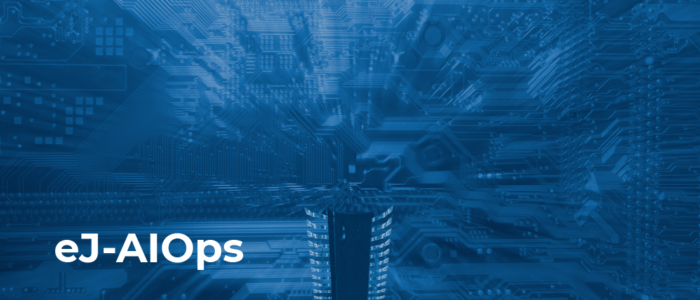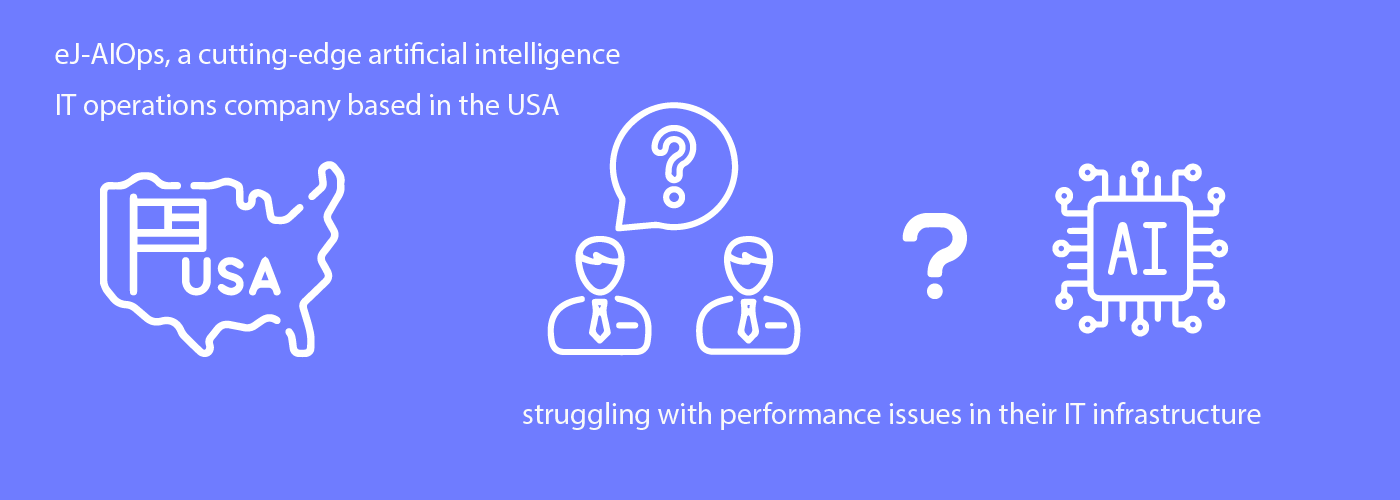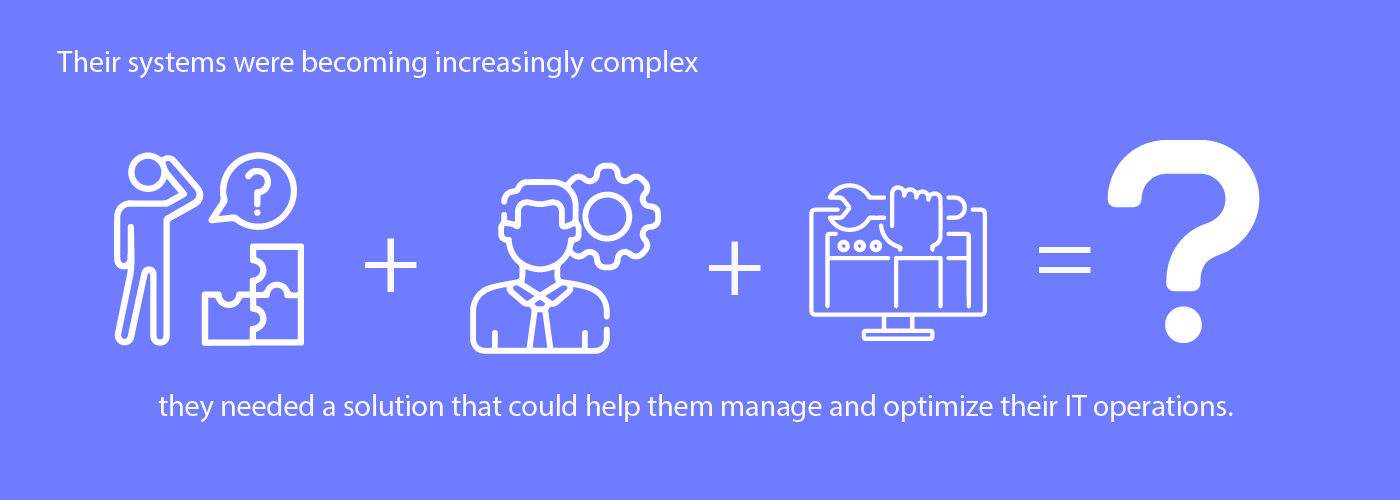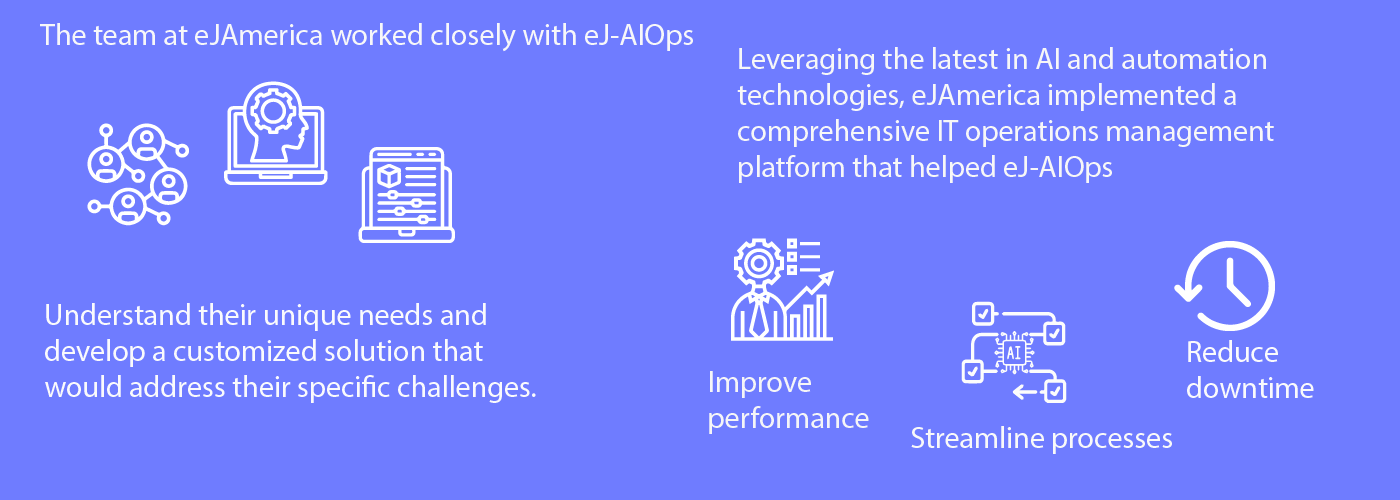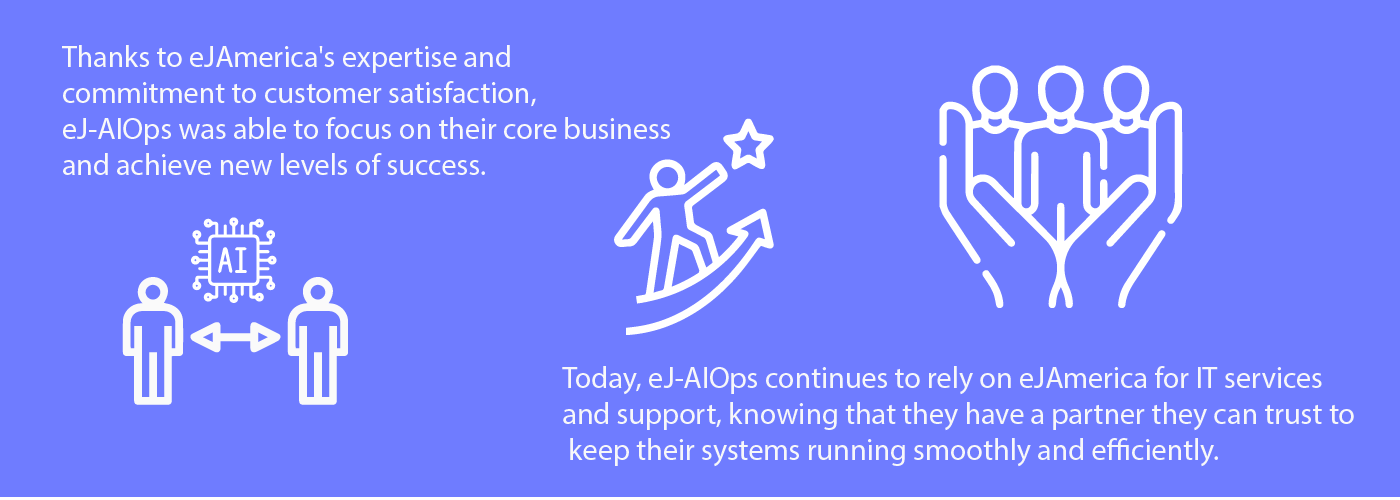eJ-AIOps
eJAmerica’s experience in enabling Artificial Intelligence in IT Operation for multiple Financial Services and Healthcare Customers.
eJ-AIOPS (Artificial Intelligence for IT Operations) is the application of artificial intelligence (AI) and machine learning (ML) techniques to IT operations management. It is a new (as of early 2023) approach to managing IT infrastructure and services that uses AI and ML to automate and optimize IT operations tasks, such as incident management, problem resolution, and performance monitoring.
Some of the key features of eJ-AIOPS include:
- Automated incident management: eJ-AIOPSuses AI and ML algorithms to automatically detect and diagnose incidents, such as network outages or system failures, and then take appropriate actions to resolve them.
- Predictive analytics: eJ-AIOPSuses predictive analytics to identify potential problems before they occur, allowing organizations to proactively prevent issues from arising.
- Root cause analysis: eJ-AIOPSuses advanced analytics and machine learning techniques to identify the root cause of an incident, and then recommend a solution to fix it.
- Real-time monitoring: eJ-AIOPSuses real-time monitoring to continuously monitor the performance of IT systems, and alert IT teams to potential issues.
- Automated workflows: eJ-AIOPSautomates repetitive and time-consuming tasks, such as patching, backups, and disaster recovery, freeing up IT teams to focus on more strategic initiatives.
- Self-healing systems: eJ-AIOPSuses AI and ML to enable systems to automatically detect and fix problems, without human intervention.
eJ-AIOPS can help organizations to improve the performance and reliability of their IT systems, reduce downtime and improve customer experience, as well as increase the efficiency of IT teams. It allows organizations to take a proactive approach to IT operations, and to quickly identify and resolve issues before they become major problems.
eJ-AIOPS platform uses machine learning algorithms to automatically detect and diagnose issues in IT infrastructure, enabling organizations to quickly resolve problems and improve performance. It integrates with a variety of monitoring and log management tools to provide a centralized view of the IT environment and offers real-time alerts, automated incident response, and customizable dashboards.
Following are some of the business challenges that eJ-AIOPS can resolve
- IT Operations: eJ-AIOPS can help organizations improve the efficiency and effectiveness of their IT operations by automating repetitive tasks, reducing downtime, and identifying and resolving issues more quickly.
- Root-cause analysis: eJ-AIOPScan helps organizations identify and resolve the underlying causes of IT issues more quickly and accurately, reducing the time and resources required to resolve problems.
- Proactive monitoring: eJ-AIOPScan helps organizations to detect potential issues before they become critical, enabling them to take proactive measures to prevent problems from occurring.
- IT service management: eJ-AIOPScan helps organizations improve the quality and availability of IT service by automating incident management, problem management, and change management processes.
- Performance optimization: eJ-AIOPS can help organizations to optimize the performance of their IT systems and applications by identifying and resolving bottlenecks and inefficiencies.
- IT cost reduction: eJ-AIOPScan helps organizations to reduce the costs of IT operations by automating tasks, reducing downtime, and improving the efficiency of IT processes.
- Business process optimization: eJ-AIOPScan helps organizations optimize their business processes by identifying and resolving IT-related issues that are impacting the performance of key business processes.
- Compliance and security: eJ-AIOPScan helps organizations to ensure compliance with regulatory requirements and to improve the security of their IT systems and applications by identifying and resolving vulnerabilities and potential threats.
- Resource optimization: eJ-AIOPScan helps organizations to optimize the use of their IT resources, such as servers, storage, and network bandwidth, by identifying and resolving issues that are impacting the performance of these resources.
- Data-driven decision making: eJ-AIOPScan helps organizations to make more informed decisions about their IT operations by providing real-time insights and analytics about the performance and health of their IT systems and applications.
The best practices and methodologies for implementing eJ-AIOPS include:
- Agile: This methodology focuses on the rapid development, testing, and deployment of AIOPS solutions.
- DevOps: This methodology emphasizes collaboration and communication between development and operations teams, and promotes the use of automation and continuous integration/deployment.
- ITIL: This methodology provides a framework for IT service management, including incident management, problem management, and change management.
- Six Sigma: This methodology focuses on process improvement and the reduction of defects and errors in IT operations.
- COBIT: This methodology provides a framework for IT governance and management, including risk management, compliance, and security.
eJ-AIOps and Operational Analytics
- Operational Analytics, in simple terms, could be hailed as the application of business analytics on operations.
- This means that tools and methods from domains such as data mining are used on data that is extracted from operations in order to extract insights and optimize decision-making.
- AIOps stands for Artificial Intelligence in IT operations. It refers to data science and AI to analyze big data from various IT and business operations tools
eJ-AIOps Vision & Goals
eJ-AIOps Goal is to increase the speed of delivery of the various services to improve IT services’ efficiency by reducing the Level-2 and Level-3 effort to save labor costs.
Other Ancillary gains of the eJ-AIOps include:
- eJ-AIOps will provide a superior user experience.
- AIOps enable themes to move away from siloed operations.
- It enables the generation of insight, which can be communicated to the stakeholders. It can help drive Automation and collaboration within an organization.
So why should an executive or a manager care about eJAIOps:
If your business has a Very large infrastructure that depends on the cloud for its day-to-day operations, then you would understand that the downtime is costly, and the service can get slow often. This would increase the cost even further. Thus, servers and cloud infrastructures need proactive management. However, the complexity of catering to this is too high.
Traditionally one would need to hire a large team that can keep a regular record of the performance and runs a periodical analysis of audit reports to attain desired goals.
While Automation in Monitoring and Event, Correlation, Aggregation Management reduces the Workload from the LEVEL-1 team, AIOPS focuses on Optimizing and reducing the effort from the LEVEL2 and LEVEL3 team. For Example, eJ’s ways of AIOPS will leverage AI for Root-Cause-Analysis, whereby reducing the LEVEL-2 Workload significantly.
eJ-AIOps Breakthrough: The premise of AIOps is that many of the level-1 issues can be solved through Automation. eJ-AIOps will enable faster root-cause analysis, predictive analytics, noise reduction, and intelligent Automation.
Over 70% of the people using AIOPS identified alert correlation and proactive issue detection as the two biggest challenges.
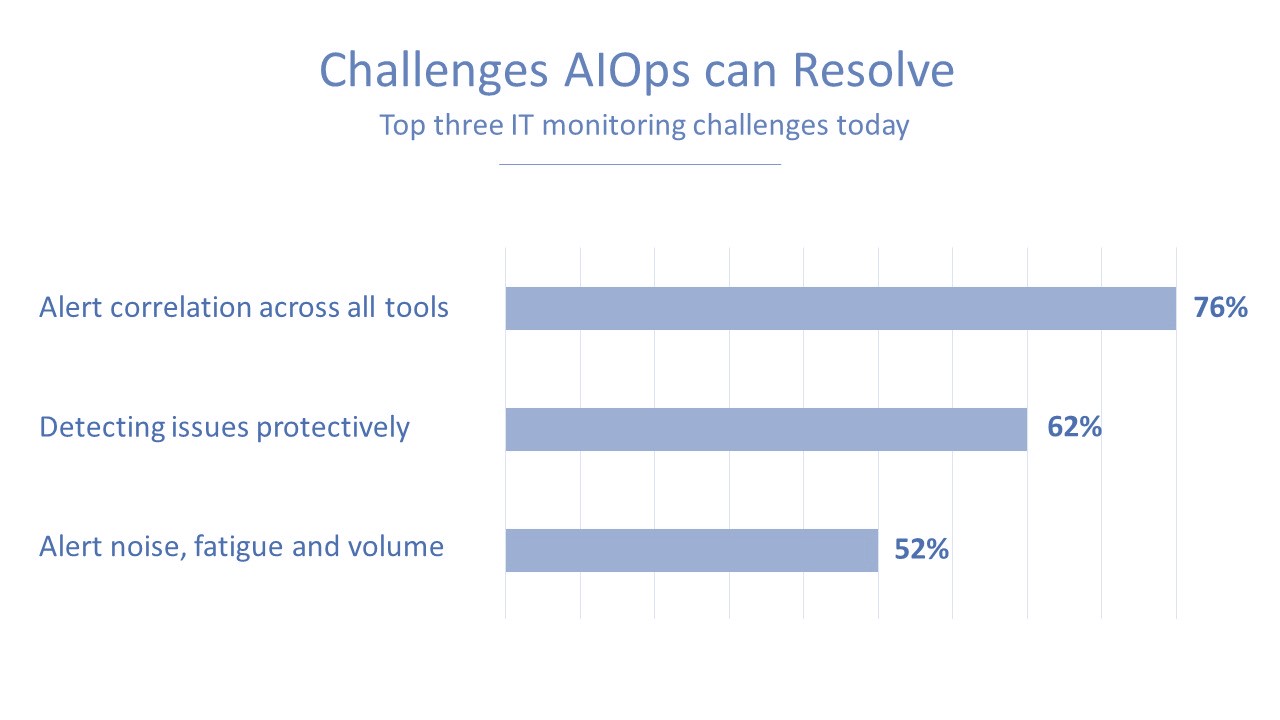
Benefits of eJ-AIOps
- eJ-AIOps helps reduce noise.
- Level-2 Effort Reduction: eJ-AIOps can help by providing faster and more accurate root-cause analysis
- eJ-AIOps automate the analysis of an event. This is directly related to the first point, and obviously, this can all help reduce alert noise.
- Alert fatigue. This refers to a case where there are so many alerts being generated by the system that humans find it difficult to handle all of them.
- If implemented correctly, we can ensure 30% Operational Cost savings
- Experience and expertise: eJAmerica has a proven track record of successfully implementing and maintaining AIOPS solutions for clients in various industries.
- Technical knowledge and skills: eJAmerica has a team of experts who are well-versed in the latest technologies and trends in the AIOPS space, and who can provide guidance and support in areas such as data analysis, machine learning, and automation.
- Flexibility and scalability: eJAmerica will be able to offer solutions that can adapt to the unique needs and requirements of each client, and that can scale as the client’s business grows.
- Integration and customization: eJAmerica has the ability to integrate AIOPS solutions with existing IT infrastructure and tools, and to customize them to meet specific business objectives.
- Support and maintenance: eJAmerica can provide ongoing support and maintenance to ensure that the AIOPS solution is running smoothly and effectively, and to address any issues that may arise.
- Cost-effective: eJAmerica offers cost-effective solutions that will provide value for money.
- Good communication and transparency: eJAmerica believes in good communication channels with the clients, and will be transparent about the progress of the project and the problems that may arise.
- Professionalism: eJAmerica has a professional attitude and approach towards the clients and their needs.
- Artificial intelligence and Machine learning: eJAmerica has a team of experts who are well-versed in the latest technologies and trends in the AI and ML space, and who can provide guidance and support in areas such as data analysis, machine learning, and automation.
- Process optimization: eJAmerica will be able to provide guidance and support in optimizing IT processes, including incident management, problem management, and change management.
eJ-AIOps Framework
Some of the key components of an eJ-AIOPS framework include:
- Data collection and analysis: This includes the collection of data from various sources, such as logs, network traffic, and performance metrics, and the use of machine learning algorithms to analyze this data and identify patterns and trends.
- Automation: This includes the use of automation tools and scripts to automate repetitive tasks and to trigger actions based on the results of data analysis.
- Monitoring and alerting: This includes the use of monitoring tools and dashboards to provide real-time visibility into the performance and health of IT systems and applications, and the use of alerts to notify IT teams of potential issues.
- Incident management: This includes the use of incident management tools and processes to quickly and efficiently resolve IT issues and restore service.
- Root-cause analysis: This includes the use of machine learning algorithms and other tools to identify the underlying causes of IT issues, so that they can be resolved more quickly and effectively.
- Continuous improvement: This includes the use of analytics and feedback loops to continuously improve the performance and effectiveness of AIOPS solutions over time.
- Scalability: The eJ-AIOPS framework should be designed to scale as the organization grows and adapts to changes in the IT environment.
- Security: The eJ-AIOPSframework should be designed to protect the organization’s IT systems and data from potential threats and vulnerabilities.
- Integration: The eJ-AIOPSframework should be able to integrate with existing IT systems and tools, and should be compatible with different types of devices and platforms.
- Governance: The eJ-AIOPSframework should be able to provide governance and compliance with regulatory requirements.
At the bottom of the stock, we have different data sources. This can be events such as alerts, or real metrics that we are using to monitor a server, such as a load of a server. Tickets are operational issues that are being investigated. And logs are logs of activity. Then, on top of this stack of data sources, we have real-time processing, rules and patterns, and domain algorithms. And these are materialized using machine learning and artificial intelligence. When using machine learning and artificial intelligence to create algorithms, they run on rules and sometimes just on pure machine learning, such as deep neural networks.
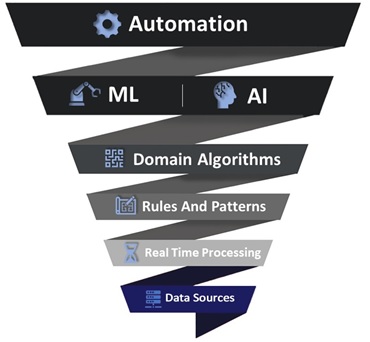
All those different data sources can be digested and then automate many of the things IT labor is doing. In this image here, Gartner, produced in 2017, can see a diagram explaining how AIOps is working.
The outer circle encapsulates business value. This is the most important component of AIOps. It creates business value by improving the quality of the service and reducing costs.
MEM (Monitoring & Event Management), Service Desk, Automation:
The second layer consists of MEM (monitoring & event management), Service Desk, and Automation.
Monitoring could first be the act of observing what is happening 24×7. The service desk refers to ticket management, giving direction between the team and the platform, and the customers. Automation is what eJAIOps, machine learning, is offering. There is another circle in the middle that talks about continuous insights. All these, the monitoring and engagement and Automation, and insights are generated by the core, which is based on machine learning and big data.
In terms of adoption, more and more enterprises will be using AIOps to support two or more major IT operations functions. AIOps is becoming more and more popular.
eJAIOPS: Tools Agnostic Smart Idea
It reduces costs and improves the quality of the service. It also caters to operational analytics. As a general guide, operational analytics, and AIOps, do not describe a single use case. AIOps is about using data signs, machine learning, AI, data mining, and data from operations to extract insight into automated processes. This means that many tools can be useful in this effort, including dashboards or various kinds of machine-learning models. There are many applications of AIOps. Optimizing the availability of a network, Automatic ticket and problem assignment, anomaly detection for cybersecurity reasons, and improving storage management. Much work in AIOps provides us with another very useful chart, on how an organization can excel in AI for IT operations.
There are many AIOPS (Artificial Intelligence for IT Operations) platforms available, and the top 20 may vary depending on the specific use case and industry. However, some of the most commonly used and well-known AIOPS tools that eJAmerica can work with are:
- AppDynamics
- Datadog
- Sumo Logic
- New Relic
- Dynatrace
- BMC TrueSight Operations Management
- Splunk
- Elasticsearch
- InfluxData
- Grafana
- Zabbix
- Nagios
- Prometheus
- Logstash
- Kibana
- Icinga
- Logrhythm
- SolarWinds
- PagerDuty
- VictorOps
- BigPanda
eJAIOPS: Multi-Phased Implementation
There are four phases, the establishment phase, the reactive phase, the proactive phase, and the expansion phase.
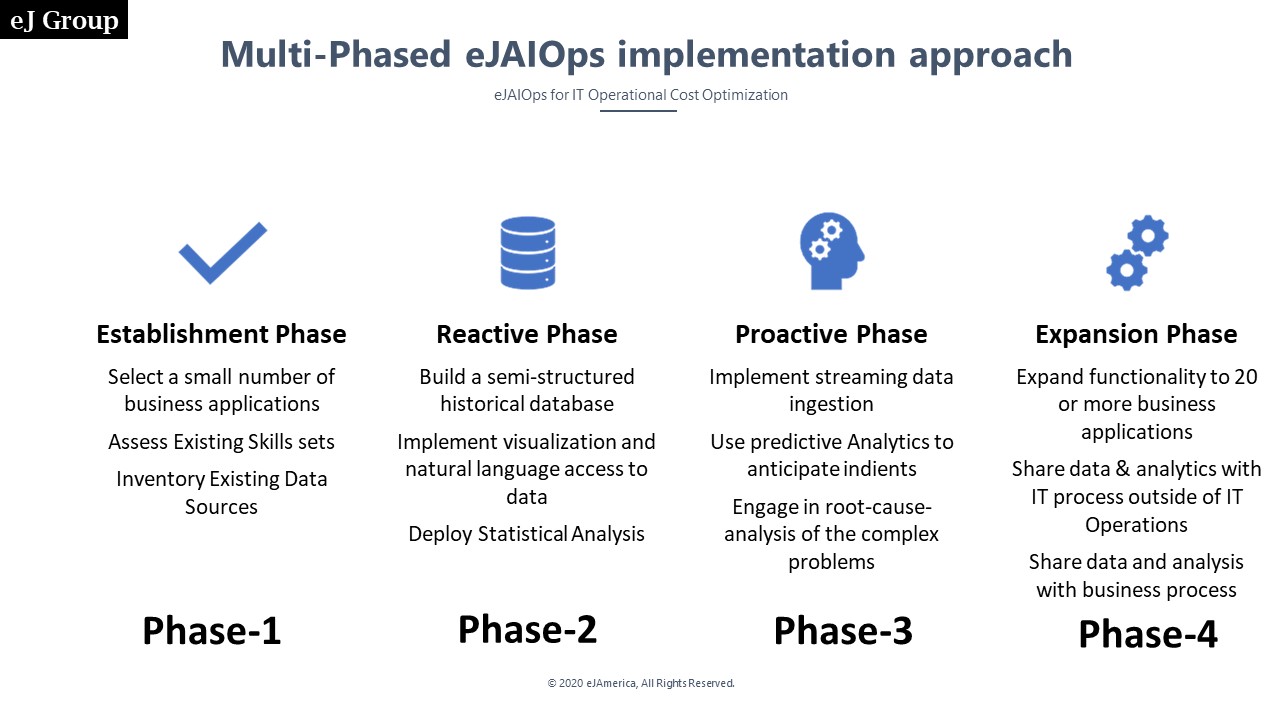
It is a very intuitive diagram. The first phase, the establishment phase, is about understanding the challenges related to operations that an organization faces. Then these challenges will be solved in the reactive and proactive phases.
The difference between the two phases is that the reactive phase is simpler from a technical perspective. In contrast, the proactive phase is more advanced because it is based on prediction.
At some point in this whole process, you want to move to prediction. You want to be able to see problems before they come. Once you can do this, you want to expand and automate as many of your operations as possible.
Talking about root cause analysis is a very interesting reference. This one is provided here for your consideration which studied the problem of identifying the root of a problem. We have many classification models and some of those are based on logic.
We saw many examples and many use cases of AIOps. We saw how AIOps could reduce costs and improve the efficiency of various services. Our industry is progressing towards greater adoption of data science and artificial intelligence in IT operations.
Please contact us to know more about eJ-AIOps and Operational Analytics.
